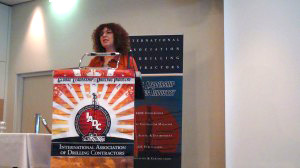Dynamic risk assessment: Helping employees ‘stay in the moment’ to take right action at right time
By Linda Hsieh, managing editor

Humans are not great at noticing change around us. “We don’t notice that gradual progression of change, and we certainly don’t notice in the workplace when we’re so concentrated on what we’re doing, and that’s known as attention blindness,” Maxine Fawcett, principal consultant for Intertek Consulting & Training, said at the 2012 IADC Drilling HSE Europe Conference in Amsterdam on 27 September. However, by providing employees with competencies for dynamic risk assessment, they can be taught to stay on a level of alertness and thus take the right action at the right time.
“Dynamic risk assessment is about how we’re able to stay in the moment, how we’re able to notice the changes that are going on around us and track them, how we re-assess danger constantly and how we’re able to step back and make the right kind of decisions and take that kind of overview,” Ms Fawcett said. Firefighters in the UK and the US, for example, specify one person to take charge of dynamic risk assessment before they go out on the job so they can really notice what’s going on and pinpoint the changes, she explained. “The worrying thing in our business is we’ve normalized and routinized everything so much that we think there is no danger and we’re not really alert to what might go wrong.”
“I know for a fact that that the toolbox talks that take place before people go out are mainly about the task and very little about the dangers that people might face, and I think that’s where dynamic risk assessment starts. It starts just before we go out and do the job so that we’re able to respond and not just react to what’s going on,” Ms Fawcett continued.
Besides attention blindness, confirmation blindness is another factor that makes dynamic risk assessment difficult. “We see what we expect to see. In our heads, we can get so wrapped up in what we think ought to be there that we’re not actually alert to what’s in front of us, and we need to be able to ask more questions as the job progresses,” she said.
Habits further influence the way people behave. “When we’re under pressure, we do what’s in the muscle. We don’t think creatively. We don’t look for different options. If we haven’t rehearsed it, if we haven’t got it in the muscle, we won’t be doing it. We fall back on what we already know,” Ms Fawcett said. If you’ve ever been in your car and realized you’ve driven to the wrong place, it’s because your mind is in one place but your body is carrying out routine behavior. “Certainly in the workplace what I’m seeing is that people get into habitual ways of working and then they can’t do the right thing at the right time when they absolutely need to, which means that we’ve got to manage the working habits that people have.”
Particularly in recent years, Ms Fawcett notes that she’s become concerned about a trend toward safety fatigue and pathological complacency, which may be stunting improvements in safety. “For me, the biggest barrier to dynamic risk is that people and organizations are getting very complacent, and the kinds of things people say is, ‘We’re good enough. We’re doing all of this. We’re good enough.’ And that isn’t good enough.”




